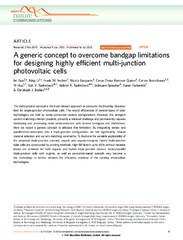Приказ основних података о документу
A generic concept to overcome bandgap limitations for designing highly efficient multi-junction photovoltaic cells
| dc.creator | Guo, Fei | |
| dc.creator | Li, Ning | |
| dc.creator | Fecher, Frank W. | |
| dc.creator | Gasparini, Nicola | |
| dc.creator | Quiroz, Cesar Omar Ramirez | |
| dc.creator | Bronnbauer, Carina | |
| dc.creator | Hou, Yi | |
| dc.creator | Radmilović, Vuk | |
| dc.creator | Radmilović, Velimir R. | |
| dc.creator | Spiecker, Erdmann | |
| dc.creator | Forberich, Karen | |
| dc.creator | Brabec, Christoph J. | |
| dc.date.accessioned | 2021-03-10T12:53:24Z | |
| dc.date.available | 2021-03-10T12:53:24Z | |
| dc.date.issued | 2015 | |
| dc.identifier.issn | 2041-1723 | |
| dc.identifier.uri | http://TechnoRep.tmf.bg.ac.rs/handle/123456789/3116 | |
| dc.description.abstract | The multi-junction concept is the most relevant approach to overcome the Shockley-Queisser limit for single-junction photovoltaic cells. The record efficiencies of several types of solar technologies are held by series-connected tandem configurations. However, the stringent current-matching criterion presents primarily a material challenge and permanently requires developing and processing novel semiconductors with desired bandgaps and thicknesses. Here we report a generic concept to alleviate this limitation. By integrating series-and parallel-interconnections into a triple-junction configuration, we find significantly relaxed material selection and current-matching constraints. To illustrate the versatile applicability of the proposed triple-junction concept, organic and organic-inorganic hybrid triple-junction solar cells are constructed by printing methods. High fill factors up to 68% without resistive losses are achieved for both organic and hybrid triple-junction devices. Series/parallel triple-junction cells with organic, as well as perovskite-based subcells may become a key technology to further advance the efficiency roadmap of the existing photovoltaic technologies. | en |
| dc.publisher | Nature Publishing Group, London | |
| dc.relation | Cluster of Excellence 'Engineering of Advanced Materials (EAM)' at the University of Erlangen-Nuremberg, Germany [EXC315] | |
| dc.relation | University of Erlangen-Nuremberg [SFB 953] | |
| dc.relation | DFG research training group GRK 1896 at the Erlangen University | |
| dc.relation | China Scholarship CouncilChina Scholarship Council | |
| dc.relation | Joint Project Helmholtz-Institute Erlangen Nurnberg (HI-ERN) [DBF01253] | |
| dc.relation | 'Aufbruch Bayern' initiative of the state of Bavaria | |
| dc.relation | info:eu-repo/grantAgreement/MESTD/Basic Research (BR or ON)/172054/RS// | |
| dc.relation | info:eu-repo/grantAgreement/MESTD/Integrated and Interdisciplinary Research (IIR or III)/45019/RS// | |
| dc.rights | openAccess | |
| dc.rights.uri | https://creativecommons.org/licenses/by/4.0/ | |
| dc.source | Nature Communications | |
| dc.title | A generic concept to overcome bandgap limitations for designing highly efficient multi-junction photovoltaic cells | en |
| dc.type | article | |
| dc.rights.license | BY | |
| dc.citation.other | 6: - | |
| dc.citation.rank | aM21 | |
| dc.citation.volume | 6 | |
| dc.identifier.doi | 10.1038/ncomms8730 | |
| dc.identifier.fulltext | http://TechnoRep.tmf.bg.ac.rs/bitstream/id/1115/3113.pdf | |
| dc.identifier.pmid | 26177808 | |
| dc.identifier.scopus | 2-s2.0-84937596831 | |
| dc.identifier.wos | 000358858500036 | |
| dc.type.version | publishedVersion |

